_We may earn revenue from the products available on this page and participate in affiliate programs. Learn more ›
_
Best Inflatable
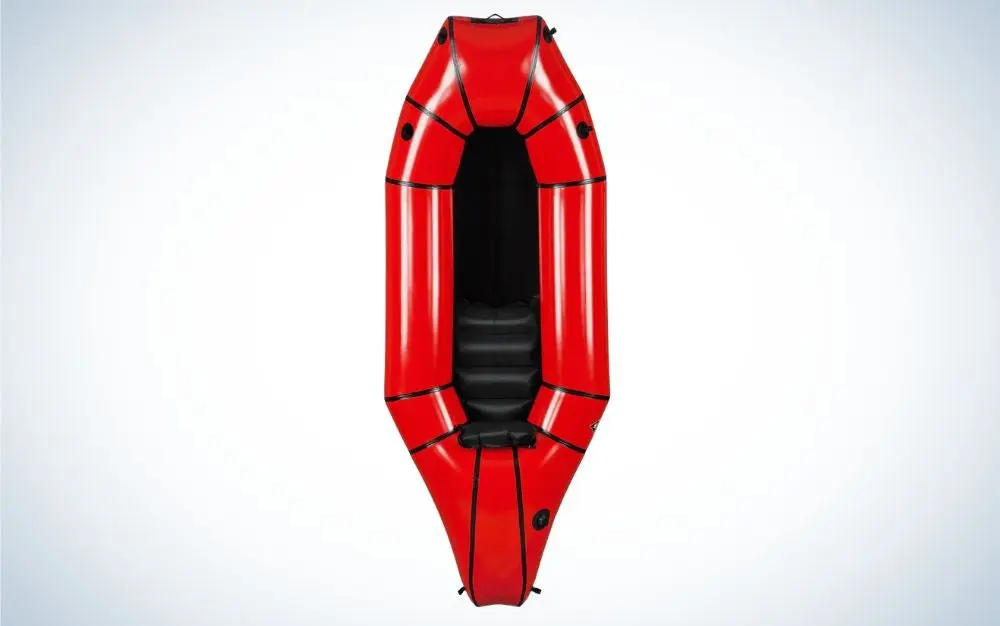
Alpacka Raft Mule
LEARN MORE
Summary
Strap it on top of your pack, and you’ll barely notice it’s there.
Best Overall
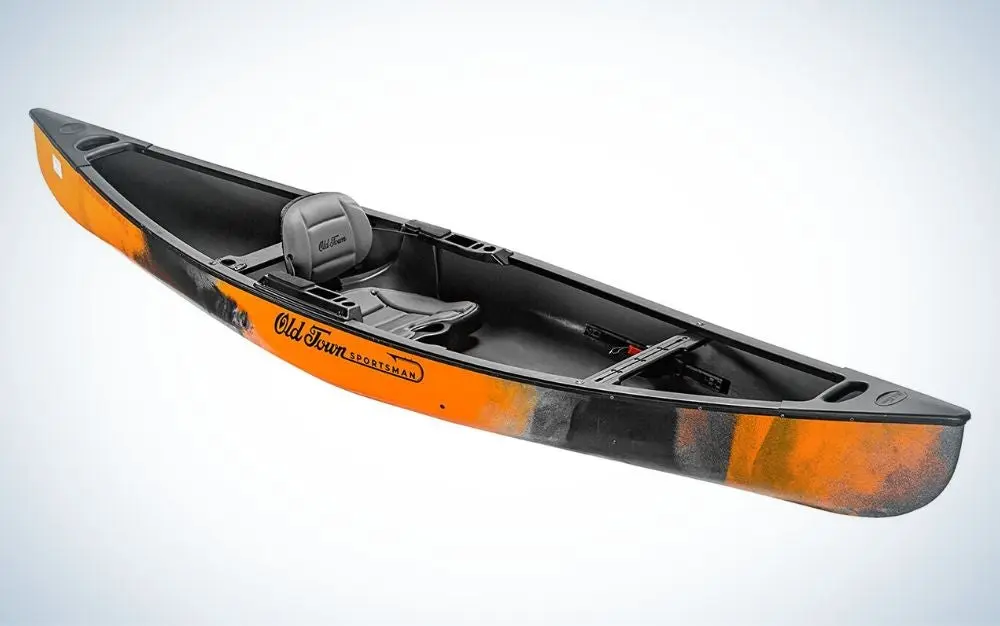
Old Town Sportsman Discovery Solo 119
LEARN MORE
Summary
It does it all, without much in the way of gingerbread…nice and simple.
Best on a Budget
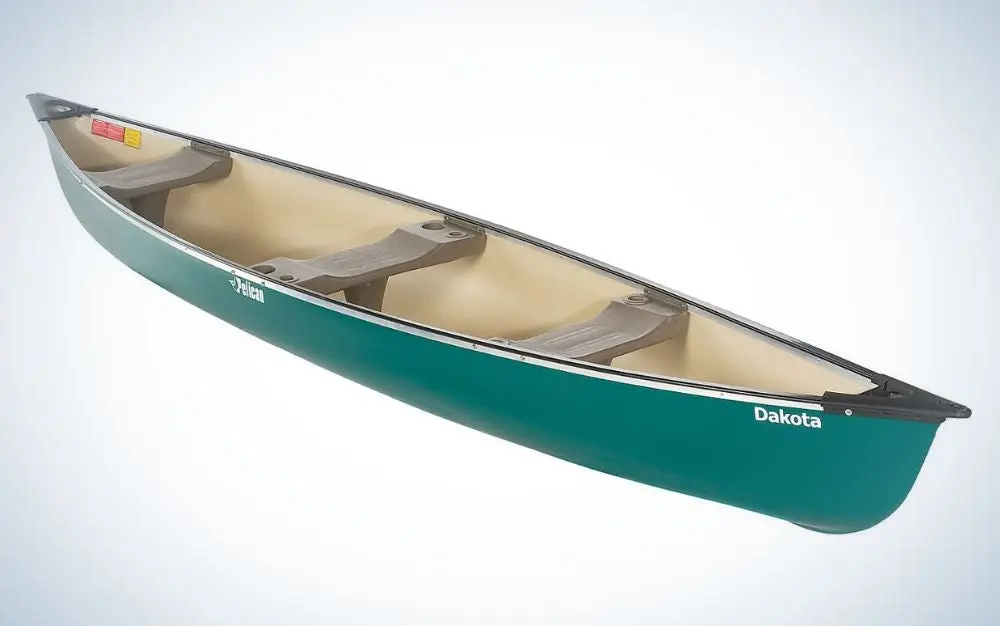
Pelican Dakota
LEARN MORE
Summary
A little heavy, but it provides a nice, non-tippy platform to fish from.
I’ll admit I didn’t grow up around fishing canoes. Never did any fishing from canoes and my pop never had one. “Too tippy,” he always said. So as my father’s son, I never spent any time around them. Small boats, yes; canoes, no.
But in 1982, I left home for Ohio University in Athens, Ohio, which just so happened to be situated along the banks of the Hocking River, one of the best all-round fisheries—and one of the best smallmouth streams—in the Midwest. Alas, though, no boat…until a teaching colleague of my aunt noticed my dismay and offered up his canoe. And, pardon the cliché, the doors were thus opened. Thanks to Pat’s lightweight Old Town (the model escapes me now) I spent hours on the Hocking in search of smallmouth, rock bass, channel cats, and sauger. True, I should have been studying accounting and philosophy, but a young man has to have his priorities straight, eh?
Since then, canoes have come and gone in my life, but one thing has always been the same, regardless of the boat specifics. Lightweight, portable, agile, and able to be launched practically anywhere, canoes have opened up fishing opportunities that, to me, would otherwise have been impossible had I been limited to a trailered skiff. Certainly, these small watercraft bear with them a learning curve in terms of the right and wrong way to propel and maneuver them. However, the benefits of paddling with spinning rod
in hand, a quiet flowage aboard a simple 60-pound skiff…well, it’s just flat nice.
Below, we’ve reviewed some of the best fishing canoes and why you ought to seriously consider making room in your garage for one.
Best Overall: Old Town Sportsman Discovery Solo 119
Best Inflatable: Alpacka Raft Mule
Best Budget: Pelican Dakota
Best Square Stern: Esquif Mallard
Best Two-Person: Pelican Explorer 14.6 DLX
How We Picked the Best Fishing Canoes
I’ve been paddling Old Town’s Sportsman Discovery Solo 119
since November, aka Duck Season, of 2020, and thus here, I’ve based quite a few of my decisions and/or criteria on my experiences with that particular skiff. As a waterfowler, I’m rough on my gear, including my boats. That’s not to say I don’t take care of and maintain them (I do) but rather they receive their fair share of abuse during Washington’s 107-day duck season. The other 258 days, or the better part of them, my a fishing canoe, and it’s used and abused in much the same manner, i.e. rocks, logs, pilings, improvised launch sites, accidental droppings, and such. So what was I looking for when I put together this list?
Reasonably lightweight, so I can load, unload, and launch the canoe by myself
Stable, as I sometimes fly-fish and like to do so standing up
Holds minimum 100-pounds of gear, though I seldom if ever carry weight like that
Good service after the sale in case I have a comment – good or not-so-good
Durability because fishing isn’t always like handling fine china
Price ranging from (approximately) $500 to $1,200
I want to be able to easily add accessories, e.g. electronics
Best Fishing Canoes: Reviews & Recommendations
Best Overall: Old Town Sportsman Discovery Solo 119
Best Overall

Specs
Weight: 56 lbs
Length: 11 ft, 9 in
Width: 32.5 in
Capacity: 298 lbs
Pros
Easy to load/unload solo
Takes a goodly amount of abuse and doesn’t cringe
Plenty of easy-to-access storage inside
Convenient rod holder design
Three color options, including a marsh camouflage
Tracks well; easy to paddle
She’s $900, if you look AND can pick her up on-site
Cons
Honestly? I have yet to find any, except for the LONG name
My personal S119 pulls double duty as both a waterfowling vessel
and fishing canoe, and I’ve been pretty darn impressed with her performance in both arenas. As an angling platform, I’ve fished everything from tiny launch-from-the-road Coast Range ponds for rainbows to the near-shore waters of the Columbia River for Fall silver salmon…even catching a 45.5” white sturgeon in 2021 from her seat. Now THAT was an experience.
The S119 is a hybrid, per se; the child of a technological match between a traditional canoe and a kayak. Though by appearances, she’s a canoe. She’s a simple craft, with few bells and whistles. But, the S119 does sport, with integrated rod holders above and below the seat, cup holder, foot braces, accessory tracks. To me, these just make her more user-friendly without complicating matters. There’s plenty of room on the interior for a small fishing cooler
, bait bucket, and tackle box, all of which can, if positioned correctly, be within easy reach. And the seat! My lower back hurts just thinking about sitting in a canoe for half a day. However, the S119’s curved and nicely padded seat takes a lot—not all, but a lot—of the pain out of remaining seated for long stretches.
Price? Shop around, and you can find the S119 for under $1,000, but you’re likely going to give $1,100 or a bit more, depending on where you find one. Find one, though, and you’ll be happy you did.
Best Inflatable: Alpacka Raft Mule
Best inflatable

Specs
Weight: 7.3 lbs
Length: 8 ft, 4 in
Width: 38 in
Capacity: 500 lbs
Pros
Multiple build options/configurations
Ability to accessorize
Easy to repair in the field, if necessary
Inflates in 3-4 minutes, with practice
You can launch the Mule damn near anywhere
Zippered cargo fly turns the raft into a giant dry bag
Cons
It’s tough, but it’s still a rubber canoe filled with air
Some might consider $1,000 for a soft canoe a little spendy
Yeah, I’ve seen what these coastal Washington rivers and streams can do to a hard boat, let alone an inflatable canoe. However, the interestingly named Alpacka Raft might just be the exception to the rule on this one.
Like my Old Town S119, the Alpacka Raft Mule, or simple Mule, pulls her weight as both a fishing canoe and a small water duck boat. She’s made of nylon/ballistic nylon, and as such, is remarkably tough; not indestructible, but more durable than one would think of a “rubber” raft. The Mule features a one-way air valve system and a separate air bag that threads onto the valve. Compressing the bag fills the chambers, and inflates the boat in mere minutes. It’s an incredibly simple and efficient system. Inflate the seat and the backrest, drop the Mule in the water, and you’re ready to go.
Let’s say you’re going on an overnight fishing trip. Equipped with the optional cargo fly, the Mule can be internally stuffed with gear—tent
, sleeping bag, blanket, pillow, single burner butane stove, cooking accessories, food, extra clothing—leaving the hull space free for you, rod/reel/tackle, and cooler. The bow bag (optional) contains your camera, licenses, and anything meant to stay dry. Done.
Best Budget: Pelican Dakota
Best Budget

Specs
Weight: 81 lbs
Length: 15 ft, 5 in
Width: 37.5 in
Capacity: 800 lbs
Pros
Price point – $425 – is tough to beat
Polyethylene build is rugged
High capacity rating
Tracks well due to full-length aluminum-reinforced keel
Third seat is a plus
Cons
A little on the heavy side, especially for one person
While I hesitate to use the words “budget” and “canoe” in the same sentence (Sure, we didn’t mind as kids, but as now sensible adults?) the Dakota from Pelican Sports hits a good stride by combining cost-savings with a quality product designed for both the newcomer and the experienced paddler alike.
Okay, so she’s a bit on the beefy side at 81-pounds, and that’s some weight and awkwardness, if you’re trying to load/unload or launch solo. Solution? Find a friend, and get them to help. Problem solved. The polyethylene (RAM-X, per Pelican) hull is incredibly tough; you’re not going to have to worry (much) about rocks and other boat-breakers. The only thing about a poly-boat is the sun, as prolonged exposure can cause the material to warp. The Dakota is, as the sticker might suggest, pretty bare bones: Three molded bench seats; flush-mounted rod holders; cup holder; carry handles fore/aft…and that’s her. But the RAM-X material is easy to work with, so adding aftermarkets, e.g. fish-finder, transducer, padded seating, or tie-downs is simple with a screw gun or, better yet, a pop-rivet gun.
Streams, rivers, lakes, or off-the-beaten path. Day-trip, or week-long fishing adventure. Pelican’s Dakota will do it, and do it well, without beating up your wallet.
Best Square Stern: Esquif Mallard
Best Square Stern
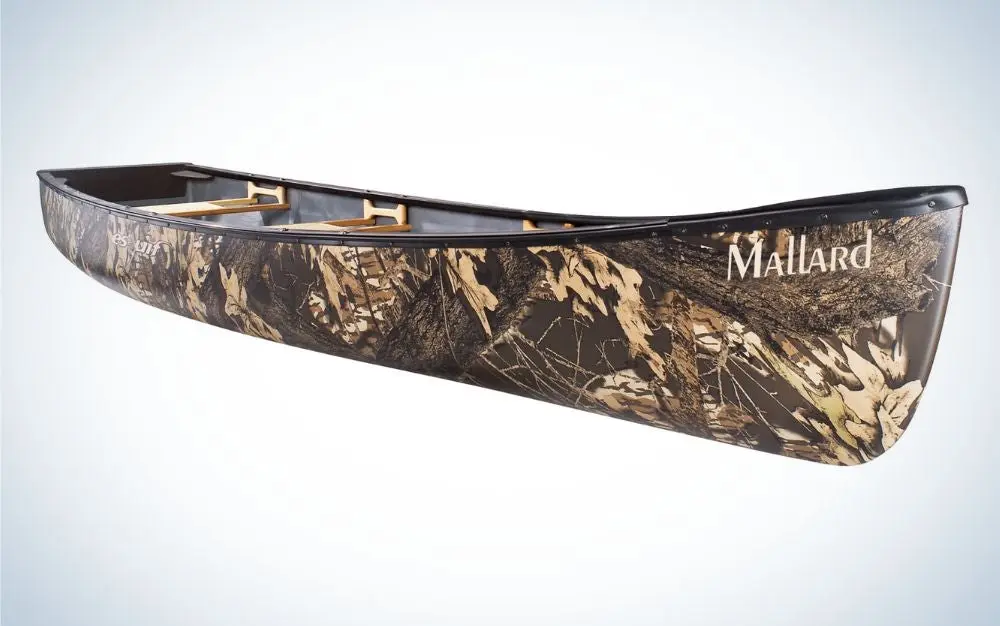
Specs
Weight: 56 lbs
Length: 12 ft
Width: 36 in
Capacity: 600 lbs
Pros
Light and easy to load/unload/portage
ABS build is tough and resistant to dings
Available in either forest green or camouflage
Double duty as fishing and/or hunting skiff
Cons
May be a tad spendy for some at $1,800
International shipping (Made in Quebec, Canada) is expensive
I’m a huge fan of things that serve more than one purpose, like, for instance, a boat that works both as a crappie fishing platform in April and a duck decoy hauler in November. Enter The Mallard by Esquif. Manufactured in Quebec, Canada, the Mallard is the quintessential all-purpose canoe, with traditional lines and all the right stuff, without going overboard on the bells and whistles.
The Mallard is constructed of an Esquif creation called T-Formex. In layman’s terms, it’s a layered abrasion/dent resistant plastic material that requires little maintenance and, with a bit of pre-work prep, is reasonably easy to accessorize and customize. She comes in either a pleasant forest green, or, for you anglers/’fowlers, Mossy Oak camouflage. Weighing only 56 pounds, the Mallard lends itself well to the solo angler, whether off-loading the skiff, negotiating one’s way downstream on quick-water between pools, or for post-adventure storage.
With her 36-inch beam, the Mallard is a stable fishing platform, a ‘plus’ for the fly angler who might prefer to stand and cast rather than sit. There’s plenty of room inside, thanks again to that 36-inch beam and a 13.5-inch depth, along with seating for three. The Mallard is rated for a 2HP outboard; a slightly longer/wider version, the Mallard XL, is also available.
Best Two-Person: Pelican Explorer 14.6 DLX
Best Two-Person
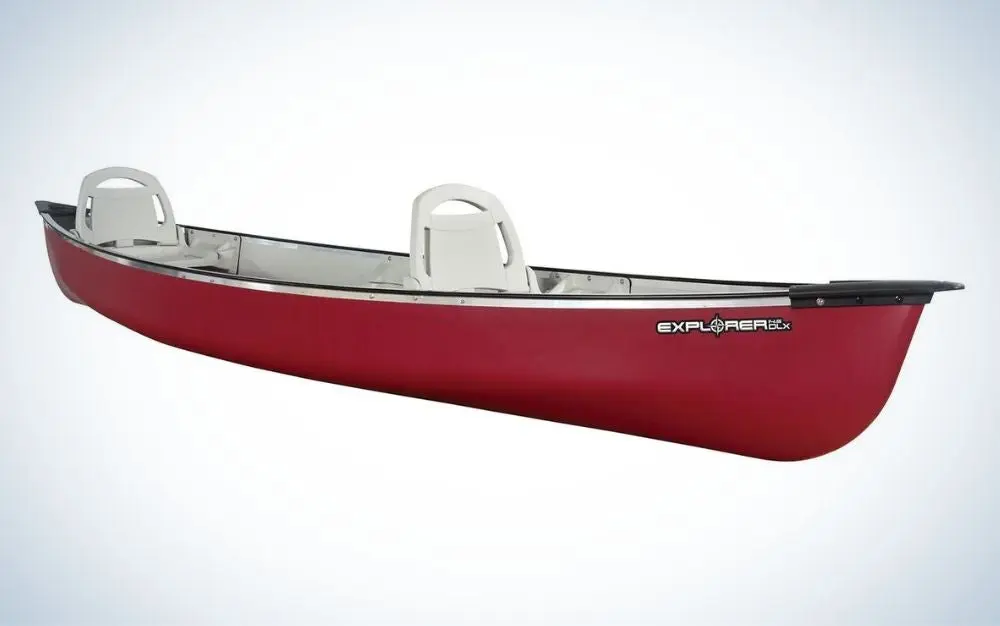
Specs
Weight: 90 lbs
Length: 14 ft, 11 in
Width: 38 in
Capacity: 800 lbs
Pros
Incredibly stable fishing platform, thanks to beam/height
High weight/gear capacity
The built-in cooler is a nice addition, and saves interior room
Price point – $600 – makes it an affordable two-person rig
RAM-X material holds up well under rough use
Cons
At 90-pounds, she’s awful heavy
If what you’re looking for is a stable canoe that’s not too big and not too small, and will actually fish two people—maybe three, if the third one seated in the middle isn’t prone to fidgeting—quite well, your search may be over, thanks to the Explorer 14.6 DLX from Pelican Sport. I’m not sure, truthfully, where the 14.6 originated as she’s almost 12-feet long; however, I’m assuming that’s an inside measurement. As for the DLX (Deluxe), there’s really nothing deluxe about the Explorer. In fact, she’s quite Spartan, which is fine for a simple fishing canoe. We’re not talking a $500,000 yacht here. There are two versions of the Explorer: one with molded bench style seats (3) and no cooler, and another with folding seats fore and aft, and the aforementioned mid-length integral cooler.
Other than being heavy and thus a touch awkward to handle, especially for one person, the Explorer does a fine job of taking folks from dry ground to where the fish live. That is, after all, what might be expected of a canoe. The RAM-X/polyethylene material is indeed durable; however, prolonged exposure to sunlight can be a bug-a-boo, causing the plastic to shape-shift slightly, albeit a temporary change. It is easy to work with, so customizing the Explorer—think adding horizontal rod holders or electronics—is a simple matter.
For the money, it’s hard to go wrong with Pelican’s Explorer 14.6.
What to Consider When Choosing a Fishing Canoe
Myself, I’d consider buying a fishing canoe a substantial purchase, not so much that they’re all expensive—They’re not!—but rather there are quite a few factors that go into matching your particular needs with the type of vessel you purchase. Variables such as:
Price
Like almost any consumer product, the best fishing canoes CAN be expensive; however, they need not be. Remember, though, you’re getting what you pay for, and do you really want to be afloat on River ‘X’ with all your gear
in the cheapest bargain basement canoe on the planet? Me? Probably not. Fortunately, there’s a wide range of price points on more-than-acceptable fishing canoes, dollar amounts stretching from $300 to more than $2,000. All depends on your budget.
Length
Fishing canoes typically run from 14 to almost 18 feet in length. Length translates elementally into three factors: Performance, how maneuverable and/or agile a canoe is; weight capacity, how much weight, including passengers and gear, it can safely carry; and stability. Are you fishing alone, or will you have someone with you? Can you pack light, or, like me, do you take everything you own aboard? Will you fish sitting down, or are you a fly angler and prefer a stable platform so you can stand? All good questions; all part of the decision.
Construction and Material
Of course, you have traditional wooden canoes, but wood requires quite a bit more work than other materials. Still, wood looks really cool! Alternatives to wood would include aluminum (lightweight), roto-molded plastics (inexpensive), fiberglass (stable), and high-techs like Kevlar (inexpensive but tough). Ask yourself here: Where will I be fishing? Will I be carrying the canoe and/or packing it into the truck or onto a roof-rack by myself?
Capacity Rating
The amount of weight a fishing canoe can safely carry (SAFELY) or its capacity is based on factors such as length, width, depth, and construction material. By rule of thumb, a 14’-foot canoe can hold approximately 700 pounds of people and gear; up that length to 17’, and now you’re talking between 1,100 and 1,200 pounds. My 12-foot Old Town Discovery 119? That number drops substantially to 300 pounds, 200 of which (UGH!) is me, so that doesn’t leave much room for stuff. That all said, it’s important that you think of both ‘what’ and ‘who’ you’ll be carrying in your new canoe.
Accessories
Seats. Paddles. Personal flotation? Par for the course, but what else are you going to want aboard, and how easy will it be to incorporate those items into the overall design? Anchor and line? Maybe a lightweight trolling motor
? Don’t forget the battery. How about electronics, e.g. a fish finder
? How easy is it to route a cable and mount a transducer for that equipment? And rod holders? Can’t forget the rod holders.
FAQs
Q: Which is better for fishing, a canoe or a kayak?
This really comes down to the type of fishing you primarily do, as well as personal preference. I favor a canoe, as I don’t venture far off-shore and neither want nor need to go out onto the ocean in something smaller than a U.S. Navy destroyer. I like the short single-bladed paddle used with a canoe rather than the longer double-bladed kayak paddle. And I like the fact that most canoes weigh less empty than do many kayaks. Finally, the canoe’s traditional appearance puts it above kayaks in my ledger. This all said, it ultimately comes down to what YOU want. (As such, we’ve also reviewed the market’s best fishing kayaks
)
Q: What length of canoe is best?
A 12-foot canoe like my Old Town Solo 119 is light, maneuverable, and plenty big for one; however, you’re not going to carry much aboard, especially if you’re planning a multiple-day adventure. A 17-foot skiff, while having a much higher weight capacity, may prove awkward, both on and off the water, particularly should you load/unload or even launch the canoe by your lonesome. A 14-foot canoe is a fine middle-of-the-road, in my opinion. It provides space and agility, without being overly weighty.
Q: What’s the safest canoe?
This one’s simple. It’s the one you don’t fall out of, injuring yourself, or worse. Big boat. Small boat. Canoe. Kayak. It really doesn’t matter; all must be operated with a good dose of common sense. For fishing purposes, a shorter (14-foot) and wider (35-40-inch) canoe with taller sides is going to provide the most stable platform. But again, safety depends on you, the skipper, and the use of common sense. And always…always…always wear your PFD.
Best Fishing Canoes: Final Thoughts
Best Overall: Old Town Sportsman Discovery Solo 119
Best Inflatable: Alpacka Raft Mule
Best Budget: Pelican Dakota
Best Square Stern: Esquif Mallard
Best Two-Person: Pelican Explorer 14.6 DLX
Canoes specifically designed for the rigors of the outdoors—and here we’re talking fishing—have the ability to open up an almost infinite realm of angling opportunities, thanks to such characteristics as weight, ease of operation, affordability, draft, portability, and safety. Today, more and more anglers are enjoying the great outdoors via one of the best fishing canoes and our nation’s waterways. It doesn’t take much: a little time, a little effort, a bit of research, and the motivation to take that first step. Oh, and a light-action spinning outfit, too.
Why Trust Us
For more than 125 years, Field & Stream has been providing readers with honest and authentic coverage of outdoor gear. Our writers and editors eat, sleep, and breathe the outdoors, and that passion comes through in our product reviews. You can count on F&S to keep you up to date on the best new gear. And when we write about a product—whether it’s a bass lure or a backpack—we cover the good and the bad, so you know exactly what to expect before you decide to make a purchase.
![Field & Stream [dev]](https://images.ctfassets.net/fbkgl98xrr9f/1GnddAVcyeew2hQvUmrFpw/e4ca91baa53a1ecd66f76b1ef472932b/mob-logo.svg)





